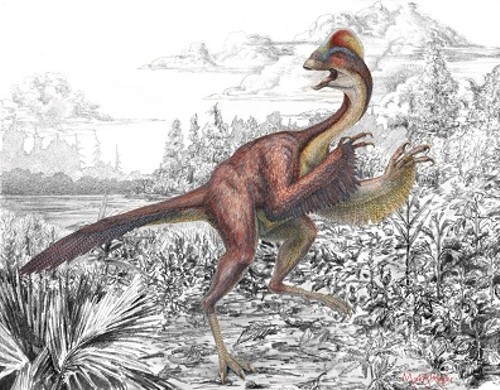Wednesday, March 19, 2014
U. Researcher Introduces "Chicken from Hell" to the World
Posted By Deann Armes on March 19, 2014, 4:17 PM
Today, University of Utah's Dr. Emma Schachner, along with scientists from the Carnegie and Smithsonian museums, unveil the Chicken From Hell: a gigantic bird-like beast belonging to a group of oviraptorosaurs, called caenagnathids, whose appearance has been a century-long mystery until now.---
Formally called Anzu wyliei, this massive bird was excavated from Hell Creek rock formation in the Dakotas. The team of scientists were shocked at what they found- a 11 ft. long, 500 pound animal with a toothless beak and an odd crest on its head. Dr. Emma Schachner, University of Utah, says this is one of the largest bird-like animals ever discovered, "A lot of the bird-like ones are quite small. They're shaped more like birds with long tails and beaks. whereas this one has a shorter tail and has a big beak, and it's giant." Schachner describes it as a cross between Australia's flightless cassowary bird and an ostrich.
The team named Anzu Wyliei after a demon-bird from Mesopotamian myth because "it kind of looks like a giant chicken," says Schachner." And it has an absurd head. It's giant and really big. It was really funny and strange looking."
When we think of raptors most of us think of the sharp-toothed, meat-eating, monsters in Jurassic Park. But Schachner says Anzu is no more related to those raptors than a dog is to a human." Its closely related but it looks different. The head is totally different. It has no teeth and it has a really large crest." So Anzu would have been prey to the speedy carnivores created by Spielberg. It's hard to be fierce without teeth. Anzu was an omnivore who probably didn't kill other dinosaurs, and was likely eaten by T-Rex on occasion." I would imagine that T-Rex would eat it if they were within close contact," Schachner explains, "because it's big but not as big as a tyrannosaur. It wouldn't have killed another large dinosaur."
"We don't know exactly what it ate, because you'd have to find an animal dead with contents of a stomach preserves. But It doesn't have big teeth so it wasn't attacking triceratops or anything like that. It was probably eating small animals, maybe insects, maybe some vegetation, maybe a mix. Omnivorous is the best guess at this point."
So, despite it's gigantic size, if Anzo ever came across a Utahraptor it probably would have been screwed, but it's unlikely the Beehive State was ever one of Anzu's stomping grounds. According to Schachner, Utah would need the right geography. "It's largely from the Dakotas and Montana. I don't know if there's any Hell Creek Formation in Utah. It's generally the Dakotas where it's been found so far." For Schachner and many other scientists this is an exciting advancement to the group of North American Oviraptorosaurs, "This whole group of animals has been a mystery for a really long time. This is the first time we have a whole skeleton of the caenagnathids."
It's also one of the youngest oviraptorosaurs known. Anzu, a close cousin to birds today, lived right up until extinction. And actually, says Schachner, "We live closer in time to Anzu than Anzu did to Stegosaurus."
More by Deann Armes
-
Michael Fenton of Ogden's Ben Lomond Hotel
Restoring the historic (and possibly haunted) hotel
- Oct 22, 2014
-
Talia Keys
SLC singer-songwriter releases solo debut, Gemini Mind
- Jun 18, 2014
-
Humble Pride
The unsung heroes of 2014's Pride Festival
- Jun 6, 2014
- More »




